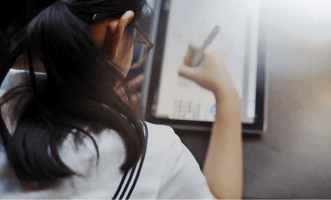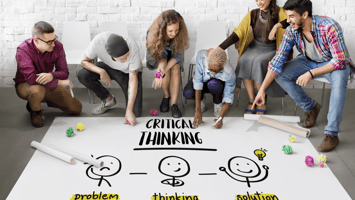This series, entitled ‘Fostering 21st Century skills in the digital classroom’ helps teachers...
K-12 online learning insights: what are 21st Century skills?
At Oppida, we believe that we all need to get better at learning collectively. But how? By giving everyone a chance to learn 21st Century skills that they can transfer between jobs. And what better place to start than with K-12 online learning for our youngest learners?
This series of blog posts entitled ‘Fostering 21st Century Skills in the Digital Classroom’ will focus on how we, as classroom teachers, can add these skills to our classrooms today.

Why change our schools now?
Unlike in the past, our schools today aren’t teaching our students the skills they need to find great jobs. According to PISA, fully one-third of Australian students lack sufficient problem solving, financial literacy or digital literacy skills.
The good news is that we can change these statistics with innovative curricula and K-12 online learning.
Today, the Australian job market looks very different to how it did 25 years ago. On the one hand, higher skilled job availability has grown considerably, such as Community/Personal Services (87%) and Professional Services (54%). On the other hand, lower skilled job availability has declined with a 37% loss for Labourers and a 35% loss for Administrators.
According to the Australian Bureau of Statistics in April 2019, there were “713,400 unemployed people in Australia which was an unemployment rate of 5.8 per cent. The unemployment rate for young people aged 15-24 years was more than twice as high at 12.9 per cent (266,000).”
This is the saddest data to hear; that so many of our young people are unemployed or underemployed, while employers complain they don’t have enough talented employees. Obviously, there’s a disconnect between employers and the education system.
So how do we help?
We give our students 21st Century skills because the fastest growing sectors demand them, starting with K-12 online learning!
So, what are 21st Century skills?
About forty years ago, private and public agencies started to talk about 21st Century skills.
But no one created a definitive list.
Instead, organisations continually tweak the list to their needs. You can check out the article on Wikipedia for a classic version or the ISTE Standards updated in 2016.
We suggest you use the version created by The Foundation for Young Australians. Unlike other organisations, they created their version by compiling data from online Australian job ads to distil the top skills identified by Australian employers for entry-level positions. This means it’s designed to give young Australians a leg up in their home market, rather than the ones created for the American market.
(The Foundation for Young Australians, 2019)
You may be thinking, “Great I’d love to help my students, but our schedule is already jam-packed.” All of the expectations placed on teachers can be overwhelming.
So, the FYA also helpfully provided data on the most sought after of these skills so you can choose which are the most important, rather than trying to implement all eight at once.
Here are the top four in-demand skills (growth by percentage from 2012-2015).
– Digital Literacy (212%)
– Critical Thinking (158%)
– Creativity (65%)
– Problem Solving (26%)
Even though Presentation Skills doesn’t make the top four (just shy at 25% growth), there’s a good case to include it as a fifth must-have skill because employees with this skill earn $8, 835 more than employees without it.
Plus, what would school be without presentations?
A few tweaks to incorporate 21st Century skills
So often, teachers baulk at new techniques because they’re afraid they’ll need to throw away all their hard work for the newest fad. Fortunately, the data from the FYA does not support that thinking.
Critical thinking is the second most sought after skill by employers.
If you’re scared of using technology and K-12 online learning in the classroom to teach 21st Century skills, this is fantastic news because there’s no special technology needed to start teaching critical thinking skills.
Here are a few ways you’re probably already encouraging this skill:
– Asking application questions on a quiz
– Encouraging a student to justify their answers
– Providing opportunities for reflection
– Brainstorming ideas
– Promoting self-editing for writing
– Asking students to explain a math solution
All of these tried and true pedagogical techniques give opportunities to practice critical thinking.
Of course, new techniques are still necessary for this day and age. So which will give you the most bang for your professional development buck?
Combine digital literacy and presentation skills
Here’s a simple definition of digital literacy: A person can choose the appropriate technology for the task, use it correctly, and maintain it afterwards.
There are two ways to teach this type of digital literacy for 21st Century skills:
- Teach students explicitly how to use one piece of presentation software (i.e. PowerPoint).
- Allow students to choose which type of technology they feel will best communicate their message.
For writing instruction, the choice between software and different types of social media can become a powerful launching point for discussions around the audience.
- Who are we targeting when we create an Instagram video story?
- Who is the target audience of a research report built into a website?
- What’s appropriate to put on this historical figure’s Facebook page?
Often, today’s entry-level jobs include managing social media accounts as part of a company’s digital marketing strategy. The good news is that there are lots of tools, such as Adobe Spark, to aid students in creating beautiful web pages and video stories. These tools also include basic design skills so students can start exploring design at school as part of their writing goals.
The bonus of beautiful design is that the students feel incredibly proud of their creations.
Conclusion
It’s clear the world of work has changed.
Even teachers have started to feel the pull of the digital revolution and K-12 online learning. Markbooks have jumped from paper onto our computer screens and, increasingly, parents have instant access to their child’s progress.
If the world of work is changing, shouldn’t the skills we’re teaching change too?
The answer is yes.
21st Century skills provide a tool for us to check that the aptitudes we’re teaching at school match those needed in the workforce. At the end of the day, we all want our children to be successful.
Look out for the next post in this series: Impact of Digital Learning on Student Voice.
Do you have any projects highlighting 21st Century skills? What tweaks are you going to be making in your classroom? Post a comment because we’d love to hear about them!
References
1) De Bortoli, Lisa and Macaskill, Greg, “Thinking it through: Australian students’ skills in creative problem solving” (2014). http://research.acer.edu.au/ozpisa/18; Thomson, Sue and De Bortoli, Lisa, “Preparing Australian students for the digital world: results from the PISA 2009 Digital Reading Literacy Assessment” (2012). https://research.acer.edu.au/ozpisa/10/; ACER (2014) Financing the future: Australia students’ results in the 2012 PISA Financial Literacy assessment.
The Foundation for Young Australians. (2019). THE NEW BASICS: Big data reveals the skills young people need for the New Work Order. Melbourne.




